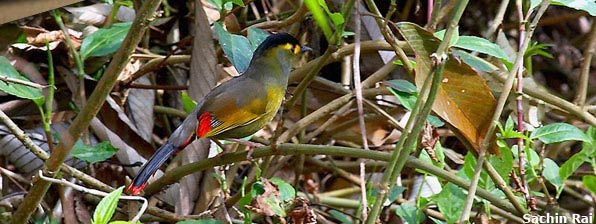Eaglenest and Assam Bird Tour
- Indira Gandhi International Airport, New Delhi, Delhi
- Culture & Nature

| Contact provider for price | 21 Days | November-April |
| Comfort accommodations | Exertion level: 3 | |
| Operator: Wild World India | 12 people max | |
Introduction: In an area covering less than 200 km, this tour takes you to diverse habitats through the marshlands of Kaziranga (alt. 50 m), the lowland evergreen forests of Nameri-Pakke (alt. 100-300 m) and the tropical and temperate broad-leaved evergreen forests of Eaglenest (alt. 100- 3300 m). Heading north of Eaglenest takes you to the drier inner valleys, conifer forests and alpine meadows of Dirang (alt. 1500-4500 m). This amazing range of altitude is matched by a stunning diversity of vegetation and fauna, with more than 750 bird species reported in this small area.
Kaziranga's rich avifauna is overshadowed by the One-horned rhinoceros for which the park is known. The marshes support many species of waterfowl and an elephant ride reveals grassland species such as Bengal Florican, Swamp Francolin and Chestnut-capped Babbler. The woodland forests are home to Blue-naped Pitta, Slender-billed Babbler, Black-breasted Parrotbill, Fairy Bluebird, Puff-throated Babblers, Silver-breasted Broadbill, Grey Peacock Pheasant and flocks of the much sought after Spot-winged Starling in winters. Tea plantations and adjoining scrub and cultivation can be explored for the Siberian Rubythroat, Rufous-necked Laughing Thrush and Thick-billed Warbler.
Nameri tiger reserve has 370 species of birds and is home to the most secure population of the White-winged Duck. In winters, the uncommon Ibisbill can be seen along the banks of the Jia Bhoroli river, which runs through the park. Some of the other species here include White-cheeked Partridge, Jerdon’s Baza, Great and Wreathed Hornbills, Ruddy-breasted Crake, Wedge-tailed Pigeon, Thick-billed Green-Pigeon, Green Imperial-Pigeon, Banded Bay Cuckoo, Silver-backed Needletail, Dollarbird, Fulvous-breasted Woodpecker, Rufous Woodpecker, Collared Broadbill, Large Wood-shrike, Siberian Rubythroat, Thick-billed Warbler, Blunt-winged Warbler, Blythe’s Reed-Warbler, Grey-bellied Tesia, and Velvet-fronted Nuthatch. The list of sought after species that you may see in this tour is vast and also includes Coral-billed scimitar-babbler, Slender-billed scimitar-babbler, Black-headed shrike-babbler, Spotted Laughingthrush, Blue-winged Laughingthrush, Rufous-breasted bush-robin, Yellow-throated fulvetta, Pied harrier, Scarlet finch, Greyheaded bullfinch, White-naped yuhina, 8 species of Wrenbabblers, Greater orange-headed parrotbill, Streak-throated barwing, Tesias, and Shortwings.
An easy road access through the pristine and diverse montane forests of Eaglenest provides ample opportunities for some spectacular birding. The nights in Eaglenest will be spent in campsites at Sessni (1250 m), Bompu (1940 m) and Lama Camp (2350 m). The use of jeeps provides us with a great deal of flexibility in choosing the altitudinal range to bird on any given day, depending on the weather conditions and our priorities. Eaglenest includes much sought after species such as Ward’s Trogon, Beautiful Nuthatch, Rufous-necked Hornbill, Bugun Liocichla, Bluefronted Robin, Chestnut-breasted Hill-Partridge, Blyth’s Tragopan, Temminck’s Tragopan, Fire-tailed Myzornis, Yellow-rumped Honeyguide, Wedge-billed Wren- Babbler, Long-billed Wren-Babbler, Cutia, Pied Falconet and Purple Cochoa.
At the drier inner valleys of Driang till Sela pass at 4200 m you may encounter species like Grandala, Black-necked Crane, Ibisbill, Long-billed Plover, Monal Pheasant, Blood Pheasant, Snow Partridge, Snowcock and Wallcreeper.
Loading map, please wait...
Locations visited/nearby
India, Asia
0 testimonials about this trip.
3 testimonials about the provider, Wild World India:
-
Reviewer: Jami Tarris & Theo Allofs
located in
Canada
We would like to thank you for making our last trip to India so successful and pleasurable. As you know, we have traveled to India twice recently, and you made this last trip convenient, efficient and so comfortable for us. As photographers our needs are many and specific, but your office staff, guides and drivers worked in concert to meet our constant demands. We appreciate your expertise and friendly customer service and we will highly recommend your company to colleagues and friends in the future. We look forward to our next photography trip to India and we look forward to working with your company again.
-
Reviewer: Daisy Gilardini
located in
Switzerland
Being a wildlife photographer all you need when traveling is the right light at the right place and moment. Light is all about photography and only Mother Nature can decide about it. Nevertheless having guides that know where and when the right light might be, helps a lot! I would like to thank Wild World India for the great support, perfect organization and best guides during our tiger-shooting safari in India.
-
Reviewer: Ruth Padel
located in
UK
Thank you so much for EVERYTHING, it was really wonderful, and your place at Vanghat is lovely. The lammergeier was the icing on the cake! Meanwhile good luck with all that you are doing and thank you again! Keep me posted on Corbett
Itinerary
Day 1 : Arrive DelhiDay 2 : Fly Delhi - Guwahati to Kaziranga
Day 3 & 4 : Kaziranga National Park
Day 5 : Kaziranga - Nameri
Day 6 & 7 : Nameri
Day 8 : Nameri - Eaglenest
Day 9 to 15 : Eaglenest
Day 16 : Eaglenest to Dirang
Day 17 & 18 : Dirang
Day 19 : Dirang - Nameri
Day 20 : Nameri - Guwahati and Fly to Delhi
More information from Wild World India:
- Email this trip page to a friend
-



Comments from Facebook